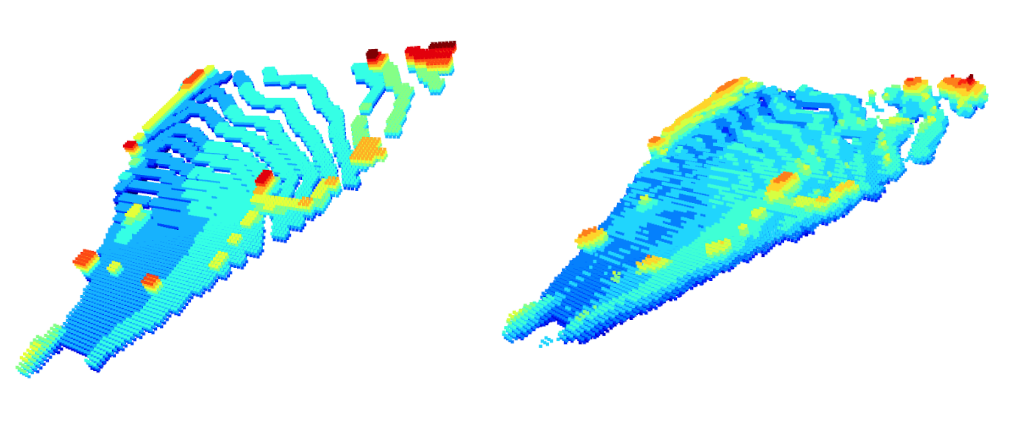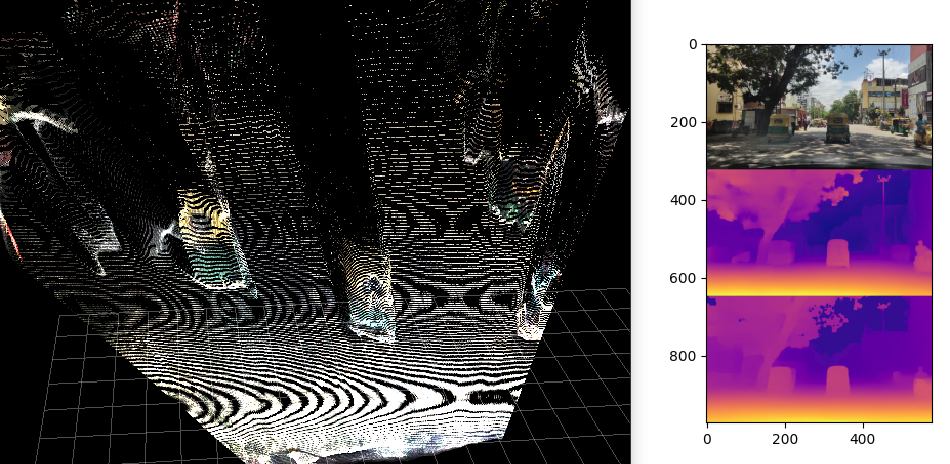Modern approaches for vision-centric environment perception for autonomous navigation make extensive use of self-supervised monocular depth estimation algorithms to predict the depth of a 3D scene using only a single camera image. However, when this depth map is projected onto 3D space, the errors in disparity are magnified, resulting in a depth estimation error that increases quadratically as the distance from the camera increases. Though Light Detection and Ranging (LiDAR) can solve this issue, it is expensive and not feasible for many applications. To address the challenge of accurate ranging with low-cost sensors, we propose a transformer architecture that uses iterative-attention to convert 2D image features into 3D occupancy features and makes use of convolution and transpose convolution to efficiently operate on spatial information. We also develop a self-supervised training pipeline to generalize the model to any scene by eliminating the need for LiDAR ground truth by substituting it with pseudo-ground truth labels obtained from neural radiance fields (NeRFs) and boosting monocular depth estimation. We will be making our code and dataset public
Please cite our paper if you find this repo helpful
@misc{analgund2023octran,
title={OCTraN: 3D Occupancy Convolutional Transformer Network in Unstructured Traffic Scenarios},
author={Ganesh, Aditya N and Pobbathi Badrinath, Dhruval and Kumar, Harshith Mohan and S, Priya and Narayan, Surabhi},
year={2023},
howpublished={Spotlight Presentation at the Transformers for Vision Workshop, CVPR},
url={https://sites.google.com/view/t4v-cvpr23/papers#h.enx3bt45p649},
note={Transformers for Vision Workshop, CVPR 2023}
}Get all submodules
git submodule update --init --recursive
Setup environment
pip install requirements.txt
- Raw dataset link - https://drive.google.com/drive/folders/1ouZk8stDobJtpDvYKBPKg0bWNR6bIX-U
- Depth Dataset link - https://drive.google.com/drive/folders/1pzDVOu_Kpo_1sSdOQvF3n7zZ44NBLdzN
- Mini Depth Dataset link - https://bit.ly/OCTraN-Dataset
Download the Mini Depth Dataset and place it at ~/Datasets/Depth_Dataset_Bengaluru/1658384924059
Run visualizer to view 3D point cloud
cd dataset_pipeline/
python3 -m dataset_helper.dataset_iteratorsThe visualizer will plot out the RGB, Boosted Disparity and non-boosted Disparity frame (in that order) from the dataset and the corresponding 3D point cloud, as shown below:
Train our model on the Raw KITTI dataset
export CUBLAS_WORKSPACE_CONFIG=:4096:8 # Determinism
CUDA_VISIBLE_DEVICES=0 python3 -m OCTraN.scripts.train_OCTraN_B --sweep_json configs/March_20/sweep_config_OCTraN_B.json
CUDA_VISIBLE_DEVICES=0 python3 -m OCTraN.scripts.train_OCTraN_V0 --sweep_json configs/March_20/sweep_config_OCTraN_V0.json
CUDA_VISIBLE_DEVICES=0 python3 -m OCTraN.scripts.train_OCTraN_V1 --sweep_json configs/March_20/sweep_config_OCTraN_V1.json
CUBLAS_WORKSPACE_CONFIG=:4096:8CUDA_VISIBLE_DEVICES=0 python3 -m OCTraN.scripts.train_OCTraN_V0 --sweep_json configs/March_20/sweep_config_OCTraN.json --name OCTraN_V0_TEST
Our work builds on and uses code from the following. We'd like to thank the authors for making these libraries available.


